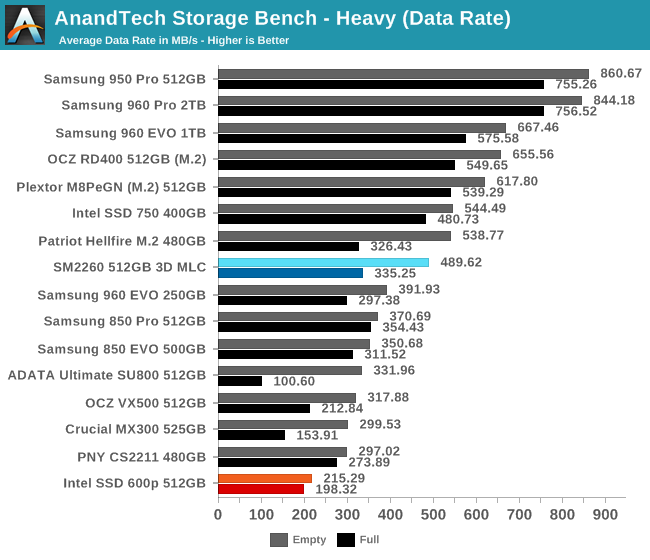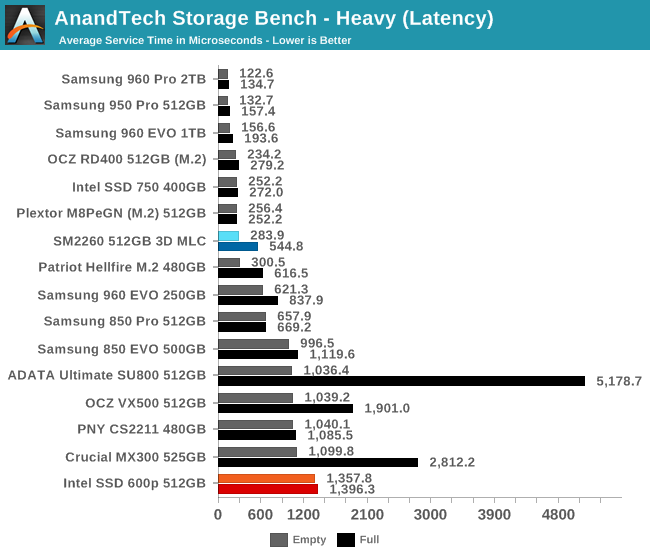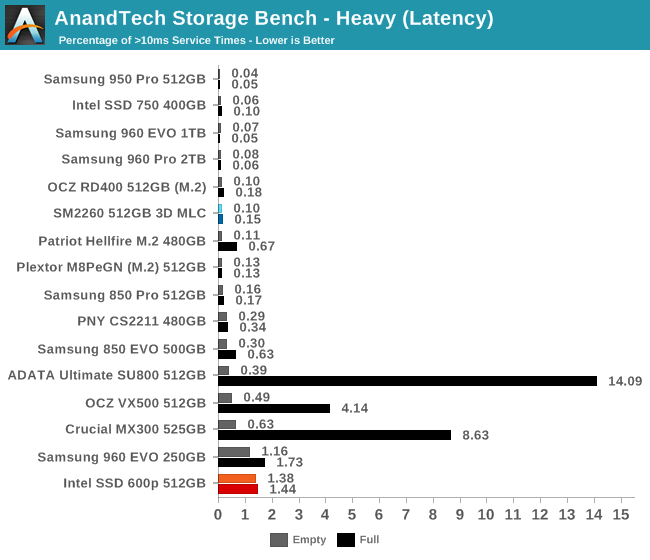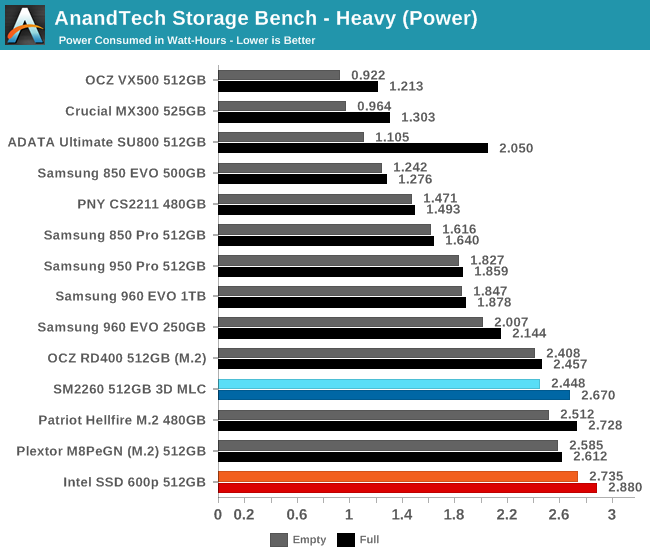Previewing Silicon Motion SM2260 NVMe Controller With 3D MLC NAND (512GB)
by Billy Tallis on February 17, 2017 9:00 AM ESTAnandTech Storage Bench - Heavy
Our Heavy storage benchmark is proportionally more write-heavy than The Destroyer, but much shorter overall. The total writes in the Heavy test aren't enough to fill the drive, so performance never drops down to steady state. This test is far more representative of a power user's day to day usage, and is heavily influenced by the drive's peak performance. The Heavy workload test details can be found here.

The SM2260 sample's average data rate on the Heavy test is a little bit slower than the Patriot Hellfire when the test is conducted starting with an empty drive, but when starting on a full drive the SM2260 has a very slight lead. The empty drive performance of the SM2260 is still significantly better than any SATA SSD, but the full drive performance drops slightly below the Samsung 850 PRO.

The average service time of the SM2260 sample was slightly better than the Patriot Hellfire for both runs of the test. At best, the SM2260 is roughly on par with the Plextor M8Pe, OCZ RD400 and Intel SSD 750, and at its worst it still holds on to a lead over the best SATA SSDs.

Full or fresh, the SM2260 keeps latency well under control during the Heavy test, where the Patriot Hellfire began to struggle with a full drive.

The SM2260 sample uses less energy over the course of the test than the Patriot Hellfire or Plextor M8Pe, and especially the Intel SSD 600p. But other than that, the power efficiency is still poor and nowhere close to what Samsung delivers.










27 Comments
View All Comments
romrunning - Friday, February 17, 2017 - link
You would have thought their design performance target would have been the older 950 Pro (not the newer 960 line) or the even-older Intel 750 . But no, it seems they are competing with Phison for the lowest-performing NVMe SSD award. Disappointing - just like that Intel 600p.ddriver - Friday, February 17, 2017 - link
First look: slow. Second look: still slow. It is quite the feat they manage to make an nvme controller almost as slow as sata.jjj - Friday, February 17, 2017 - link
Guess it's a sub 200$ drive, we'll see how it does against WD's offering and Plextor M8Se.Not worth wasting the M.2 slot on such a drive, unless it's well bellow 200$. Right now on Newegg, the M8Pe without a shield is 220$.
kissiel - Friday, February 17, 2017 - link
Isn't the Z97Pro bottlenecking the drive?AFAIK it's pcie2.0 x 2 - > so sub 1GiB/s tops.
revanchrist - Friday, February 17, 2017 - link
True that. It's a 10Gbps M.2 rather than the newer 32Gbps M.2 slot.fanofanand - Friday, February 17, 2017 - link
Nice catch! Strange for one of the top tech sites in the world to use old tech to test new tech. Very strange indeed. Ryan? Can you squeeze Purch to get some current equipment into your reviewer's hands?DanNeely - Friday, February 17, 2017 - link
I don't think so. The last page of the article shows the card in a x4 PCIe adapter. AFAIK that's plugged into 3.0 lanes from the CPU both for performance testing and to monitor the power draw.Billy Tallis - Friday, February 17, 2017 - link
Exactly right. All PCIe SSDs are tested in the PCIe 3.0 x16 slot with a riser card that has the power measurement points on it. Although, I did also test the Intel 600p in the motherboard's M.2 slot to see how much the slowest NVMe drive would be affected.kissiel - Saturday, February 18, 2017 - link
Thanks!Please consider pointing that out in a test bed info next time, so people will know what to expect with a similar combo (z97+m.2).
Keep up, the good work!
TelstarTOS - Friday, February 17, 2017 - link
Another piece of crap. This controller should be trashed away.